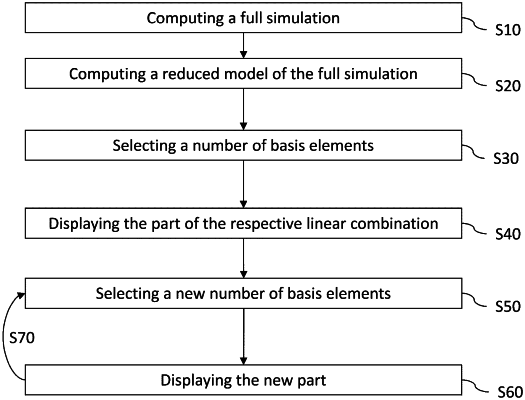| CPC G06F 30/20 (2020.01) [G06F 17/13 (2013.01); G06F 17/18 (2013.01)] | 6 Claims |

|
1. A computer-implemented method for displaying, on a second computer, in an enhanced manner, a simulation computed on a first computer, the first computer and the second computer being connected through a network, while reducing bandwidth use of the network for the displaying, the computer-implemented method comprising:
on the first computer, computing a full simulation that comprises states;
on the second computer, computing a reduced model of the computed full simulation, the reduced model comprising a basis of ordered energy modes of the full simulation, the basis of ordered energy modes comprising an energy mode that is ordered first in the basis, each state of the full simulation being represented in the reduced model by a respective linear combination of one or more of the ordered energy modes, where any linear combination of the ordered energy modes of the basis is associated with a respective simulation compression ratio and a respective reconstruction error, the respective simulation compression ratio being a ratio between an amount of data required for the displaying the state represented in the reduced model by the respective linear combination of the one or more of the ordered energy modes and an amount of data required for the displaying the respective linear combination of the one or more energy modes, the respective reconstruction error being a distance between the state represented in the reduced model by the respective linear combination of the one or more of the ordered energy modes and the respective linear combination, the energy mode ordered first in the basis being the energy mode of the basis associated with a smallest respective reconstruction error;
selecting a number N of energy modes including the one or more of the ordered energy modes in the basis;
displaying, on a display of the second computer and in the enhanced manner, for at least one state of the full simulation, a part of the respective linear combination that comprises the number N energy modes in the basis, the part representing the at least one state in the reduced model, the number N being modifiable so that the respective simulation compression ratio associated with the part of the respective linear combination is adapted to a network load of the network; and
automatically during the displaying on the second computer, for a given simulation compression ratio value that corresponds to a maximal allowed simulation-dedicated network load, repeating, until a simulation-dedicated network load reaches the maximal allowed simulation-dedicated network load, by either the first computer or the second computer:
determining that a current simulation-dedicated network load is either smaller than or larger than the maximal allowed simulation-dedicated network load by determining that the respective simulation compression ratio of the part is either smaller than or larger than the given simulation compression ratio value, and
upon determining that the current simulation-dedicated network load is either smaller than or larger than the maximal allowed simulation-dedicated network load, modulating the network load of the network by modifying the respective simulation compression ratio of the part by modifying the number N and updating the displaying according to the modified number N.
|